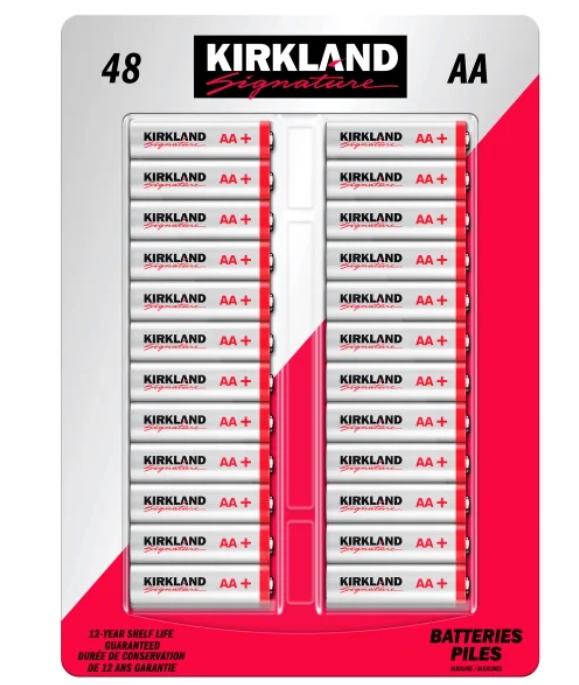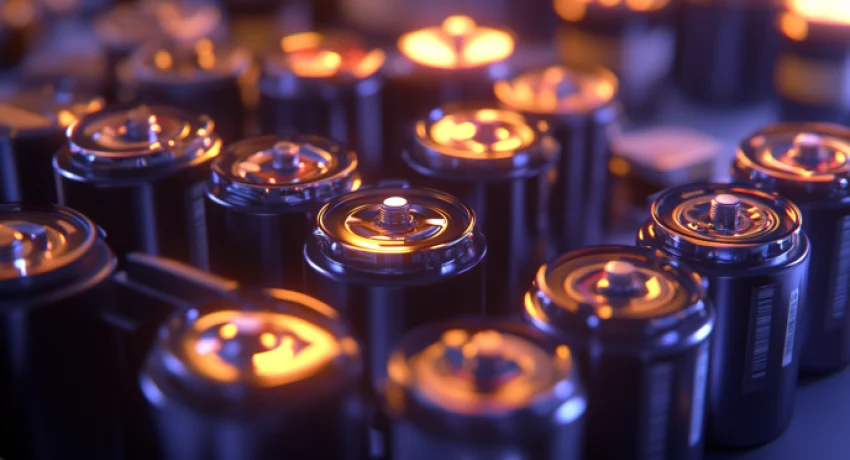
Kirkland Signature Alkaline AA Batteries, 48-count
- 12-Year Shelf Life
- No Mercury Added
Unveiling Costco’s Hidden Power Source That Won’t Break the Bank
In a world increasingly dependent on portable power, finding reliable batteries that deliver performance without emptying your wallet has become something of a modern quest. Enter Kirkland Signature batteries – Costco’s house brand that has quietly developed a loyal following among savvy shoppers. But what’s really behind these unassuming power cells? Are they truly the budget-friendly powerhouse they claim to be, or simply another mediocre store brand trying to compete with the big names? Today, we’re diving deep into everything Kirkland batteries have to offer.
As someone who’s gone through more batteries than I care to admit (thanks, wireless gaming controllers and endless remote controls!), I’ve had my fair share of experiences with various battery brands. After years of switching between premium options and budget alternatives, I stumbled upon Kirkland batteries during a routine Costco run, and my power supply strategy has never been the same.
Kirkland Signature batteries offer exceptional value without sacrificing performance, making them one of Costco’s most underrated products. But don’t just take my word for it—let’s explore the complete story behind these batteries, from types and pricing to performance and environmental impact.
The Kirkland Battery Lineup: More Options Than You Might Think
When most people think of Kirkland batteries, they immediately picture the ubiquitous AA and AAA alkaline batteries in their distinctive packaging. However, Costco’s battery offerings extend beyond these common sizes.
Alkaline vs. Rechargeable: What Kirkland Actually Offers
Kirkland Signature primarily offers alkaline batteries, which make up the bulk of their battery product line. These non-rechargeable batteries are designed for one-time use and are perfect for devices with moderate power demands. Their alkaline lineup includes:
- AA batteries (the most popular size)
- AAA batteries (for smaller devices)
- C batteries (less common, but available)
- D batteries (for high-power devices)
- 9-volt batteries (typically for smoke detectors)
Contrary to what some might believe, Kirkland does not currently manufacture rechargeable batteries under their house brand. This is an important distinction, as some shoppers mistakenly look for Kirkland rechargeables. If you’re specifically in the market for rechargeable options, you’ll need to look at other brands Costco carries, such as Energizer or Duracell rechargeable lines.
The Bulk Advantage: Quantity and Packaging
One of the most appealing aspects of Kirkland batteries is how they’re sold. True to Costco’s wholesale model, these batteries come in bulk packaging that offers significant value:
- AA batteries typically come in packs of 48
- AAA batteries are commonly sold in packs of 48
- C and D batteries usually come in smaller quantities of 14-20
- 9-volt batteries are available in packs of 12
This bulk packaging is perfect for families, offices, or anyone who uses batteries regularly. Rather than making emergency runs to the convenience store (and paying premium prices) when your remote dies, having a substantial supply on hand means you’re always prepared.
The Price Point: A Major Draw for Budget-Conscious Shoppers
Let’s talk about one of the most compelling reasons people choose Kirkland batteries: the price. In an age where inflation seems to touch everything, finding genuine value matters more than ever.
Current Pricing at Costco (As of 2024)
While prices may vary slightly by location and can change over time, here’s the general pricing structure for Kirkland batteries:
- 48-pack of AA batteries: approximately $14.99-$16.99
- 48-pack of AAA batteries: approximately $14.99-$16.99
- 14-pack of C batteries: approximately $12.99-$14.99
- 14-pack of D batteries: approximately $12.99-$14.99
- 12-pack of 9-volt batteries: approximately $17.99-$19.99
This translates to roughly 31-35 cents per AA or AAA battery, which is significantly less than what you’d pay for equivalent name-brand options at most retailers. Even when Duracell or Energizer go on sale, they rarely match the per-unit cost of Kirkland batteries.
Value Comparison: Kirkland vs. Major Brands
To put this in perspective, let’s compare to major brands:
When purchasing name brands like Duracell or Energizer at typical retail prices, you might pay anywhere from 75 cents to over $1 per battery when buying smaller packages. Even in larger packs, name brands typically cost 50-75 cents per battery.
This means Kirkland batteries often cost 40-60% less than their name-brand counterparts. For a family that goes through dozens of batteries each year, the savings can easily add up to $50-100 annually.
Performance Questions: Do Cheap Batteries Mean Poor Performance?
The skepticism is understandable. After all, we’ve all been burned by “bargain” products that turned out to be false economies. So how do Kirkland batteries actually perform?
Performance in High-Drain Devices
One of the most critical tests for any battery is how it handles high-drain devices—those electronics that demand significant power, like digital cameras, video game controllers, or children’s toys with motors or lights.
Kirkland alkaline batteries perform surprisingly well in high-drain devices, especially considering their price point. While they may not quite match the absolute top-tier performance of premium Duracell or Energizer options in the most demanding applications, the difference is less significant than many would expect.
For example, in digital cameras, Kirkland batteries typically provide about 85-90% of the shots you might get from premium brands before needing replacement. In wireless game controllers, users report comparable play time between charges.
Where Kirkland batteries really shine is in moderate-drain devices like remote controls, clocks, and basic toys. In these applications, the performance difference between Kirkland and premium brands becomes nearly indistinguishable to the average user.
Longevity and Shelf Life
Another key aspect of battery quality is shelf life—how long the batteries maintain their charge while sitting unused.
Kirkland alkaline batteries have an impressive shelf life of up to 10 years when stored properly in cool, dry conditions. This means you can stock up without worrying about your supply losing potency before you have a chance to use them.
When it comes to operational longevity—how long the batteries last while in use—Kirkland batteries offer competitive performance. In standard devices like remote controls, wall clocks, or basic LED flashlights, users typically report minimal difference in longevity compared to major brands.
The Origin Story: Who Actually Makes Kirkland Batteries?
One of the most interesting aspects of Kirkland batteries is their manufacturing origin. Like many Costco Kirkland Signature products, these batteries aren’t actually produced by Costco itself but are instead manufactured by a major industry player.
The Duracell Connection
While Costco doesn’t officially advertise this fact, industry insiders and multiple independent analyses have confirmed that Kirkland Signature batteries are manufactured by Duracell. Yes, the same Duracell known for their premium batteries with the copper-top design.
This arrangement is what’s known as “private labeling” in the retail industry, where a major manufacturer produces items for a retailer to sell under their own brand name. It’s a common practice that benefits both parties: the manufacturer gets additional production volume, and the retailer gets a quality product they can sell at a competitive price.
This Duracell connection explains why Kirkland batteries perform so well compared to premium brands—they essentially are a premium brand, just in different packaging and at a lower price point.
Why the Discount if They’re Made by Duracell?
If Kirkland batteries are made by Duracell, why the significant price difference? Several factors come into play:
- Bulk packaging reduces individual unit costs
- Costco’s efficient retail model eliminates several layers of distribution markup
- Limited marketing costs (no expensive TV commercials or sponsorships)
- Costco’s willingness to accept lower profit margins to drive membership value
This combination of factors allows Costco to offer what is essentially a premium battery at a significantly reduced price point.
Reliability for Everyday Use: What Users Actually Report
Beyond specifications and pricing, what matters most is real-world performance. How do Kirkland batteries hold up in day-to-day use?
Consumer Satisfaction Levels
Consumer feedback on Kirkland batteries is overwhelmingly positive. On Costco’s website, these batteries consistently receive ratings between 4.7 and 4.9 out of 5 stars, with thousands of reviews.
Common themes in positive reviews include:
- Consistent performance across different devices
- Excellent value for the price
- Longevity comparable to name brands
- Convenience of bulk packaging
- No noticeable quality difference from premium brands in most applications
Negative reviews are relatively rare but typically mention:
- Occasional duds in large packages (though statistically in line with industry averages)
- Slightly shorter life in very high-drain professional equipment
- Packaging that can be cumbersome to store
Leakage Protection: A Critical Reliability Factor
Battery leakage can damage expensive electronics, which makes leak resistance an important quality factor. Kirkland batteries include anti-leak technology similar to that found in premium brands.
While no alkaline battery is completely immune to leaking (especially when left in devices beyond their useful life), Kirkland batteries have a good track record in this regard. Their leak protection appears to be on par with major brands, with similar failure rates reported by consumers.
Environmental Considerations: The Eco Question
As environmental awareness grows, the ecological impact of disposable batteries has become a more prominent concern for many consumers.
Recyclability of Kirkland Batteries
Like all alkaline batteries, Kirkland batteries are considered non-hazardous waste in most jurisdictions. While they don’t contain the toxic heavy metals present in older battery technologies, they do contain materials that can be recycled.
Kirkland alkaline batteries can be recycled through specialized battery recycling programs. Many Costco locations provide battery recycling collection points, making it convenient to responsibly dispose of used batteries during your next shopping trip.
The recycling process recovers metals like zinc, manganese, and steel, which can be reused in manufacturing new products. While the recycling rate for alkaline batteries remains lower than ideal, the infrastructure is improving.
Environmental Impact Compared to Rechargeables
From an environmental perspective, rechargeable batteries generally have a lower lifetime impact than disposable alkalines, including Kirkland batteries. A single rechargeable battery can replace hundreds of disposable batteries over its lifespan.
However, for devices with very low power draw or infrequent use, alkaline batteries like Kirkland’s remain a practical option. Devices like smoke detectors, wall clocks, or rarely-used remotes may actually be better suited to alkaline batteries than rechargeables, which can lose their charge during long periods of disuse.
Specialized Uses: Beyond the Basics
Not all battery applications are created equal. How do Kirkland batteries perform in more specialized scenarios?
Performance in Cameras and Sensitive Electronics
Digital cameras, especially those with flash functions, are among the most demanding devices for batteries. While dedicated photography enthusiasts might prefer specialized lithium batteries for maximum performance, Kirkland alkalines provide reasonable performance for casual photography.
For everyday digital camera use, Kirkland batteries typically allow for hundreds of shots, though perhaps 10-15% fewer than premium lithium options. Given the significant price difference, many consumers find this a worthwhile tradeoff for non-professional photography.
Safety for Children’s Toys
Parents are understandably concerned about safety when it comes to products used in children’s toys. Kirkland batteries meet all standard safety regulations for consumer batteries in the United States and other markets where they’re sold.
Their leak protection technology helps reduce the risk of battery acid exposure, though as with any battery, proper handling and timely replacement remain important safety practices. Parents should always ensure battery compartments in toys are secure and not accessible to young children.
Practical Considerations: From Storage to Special Situations
Beyond performance and price, there are practical aspects of Kirkland batteries worth considering for informed consumers.
Expiration and Proper Storage
All Kirkland Signature battery packages clearly display an expiration date, typically 10 years from the date of manufacture. This long shelf life makes them ideal for stockpiling during sales or for emergency preparedness kits.
For maximum longevity, store Kirkland batteries:
- In a cool, dry place (not refrigerated, contrary to popular belief)
- In their original packaging until needed
- Away from metal objects that could cause short circuits
- At room temperature, avoiding extreme heat or cold
Proper storage ensures your battery supply remains potent and ready when needed.
Kirkland’s Satisfaction Guarantee
Like all Kirkland Signature products, their batteries are backed by Costco’s satisfaction guarantee. If you’re dissatisfied with the performance of your Kirkland batteries for any reason, Costco will typically refund your purchase with minimal hassle.
This guarantee provides additional peace of mind when purchasing in bulk, knowing that you’re not committed to dozens of potentially underperforming batteries.
The Competition: How Kirkland Stacks Up Against Major Brands
To truly understand Kirkland batteries’ value proposition, we need to compare them directly with their major competitors.
Kirkland vs. Duracell: The Parent Company Comparison
Since Duracell is widely believed to be the manufacturer of Kirkland batteries, this comparison is particularly interesting. In terms of basic chemistry and construction, the batteries are quite similar, though there may be minor differences in formulation.
In performance testing, Kirkland batteries typically deliver 90-95% of the performance of Duracell batteries in identical applications. However, Kirkland batteries usually cost 40-50% less than branded Duracell products.
This creates a compelling value equation: Is the last 5-10% of performance worth paying nearly twice as much? For most consumers and most applications, the answer is clearly no.
Kirkland vs. Energizer: Another Premium Alternative
Energizer represents another premium alternative to Kirkland batteries. The performance comparison is similar to the Duracell scenario, with Kirkland delivering strong performance at a significantly lower price point.
One area where premium brands like Energizer sometimes hold an advantage is in very high-drain professional applications or extreme environmental conditions. However, for typical household use, these advantages rarely justify the price premium for most consumers.
Making the Smart Choice: When to Choose Kirkland
With all this information, when does it make sense to choose Kirkland batteries over alternatives?
Ideal Use Cases for Kirkland Batteries
Kirkland batteries are an excellent choice for:
- Households with multiple battery-powered devices
- Offices that need to keep supplies for various electronics
- Emergency preparedness kits where battery quantity matters
- Standard consumer electronics like remotes, clocks, and basic toys
- Anyone looking to reduce their battery budget without sacrificing quality
The bulk packaging particularly suits situations where having a ready supply of batteries prevents inconvenient emergency purchases at premium prices.
When You Might Consider Alternatives
There are some situations where alternatives might be worth considering:
- For professional photography or very high-drain specialty equipment, lithium batteries may offer performance advantages worth their premium price
- For devices that see extremely heavy use, rechargeable batteries may offer better long-term value and environmental benefits
- For very rarely used devices or long-term storage (emergency equipment), lithium batteries with their even longer shelf life might be preferable
The Verdict: Are Kirkland Batteries Worth It?
After examining every aspect of Kirkland Signature batteries, from their manufacturing origins to their performance in various applications, the conclusion is clear: Kirkland batteries represent one of the best values in consumer batteries available today.
By leveraging Costco’s efficient business model and minimizing marketing costs, these batteries deliver near-premium performance at a significantly reduced price point. The fact that they’re manufactured by a leading battery company further supports their quality credentials.
For the vast majority of consumers and the vast majority of applications, Kirkland batteries strike an optimal balance between performance and price. Their bulk packaging ensures you’re never caught without power, while their quality ensures that your devices perform reliably.
Next time you’re at Costco, those distinctive battery packages might be worth a second look—your devices (and your wallet) will likely thank you for making the switch. While no product is perfect for every situation, Kirkland batteries have earned their reputation as a smart choice for informed consumers.
Whether you’re powering remote controls, children’s toys, smoke detectors, or any of the countless battery-operated devices in modern homes, Kirkland Signature batteries offer a compelling combination of quality, reliability, and value that’s increasingly rare in today’s consumer landscape.




